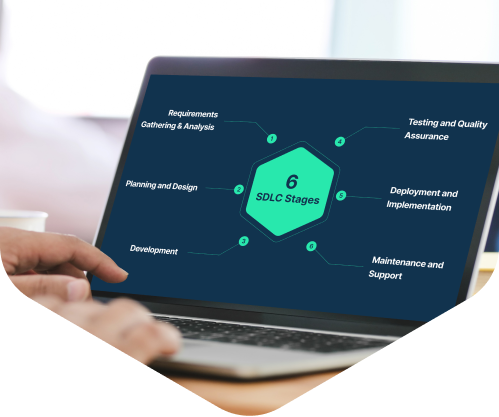The 6 Stages of the Software Development Life Cycle
The software development life cycle defines the stages of turning an idea into a marketable software product. It involves several roles, including product managers, developers, designers, and QA testers.
There are many approaches to the product development life cycle. Not everyone agrees on the number of stages it involves or the definition of those stages.
For example, some product development companies define the first two stages as Planning and Analysis and Define Requirements for a total of seven steps. Others (like Taazaa) combine them into a Requirements Gathering and Analysis stage.
Let’s look at the seven stages of a typical software product development life cycle and the different SDLC models that can be used.
Stage 1: Requirements Gathering and Analysis
In the requirements gathering and analysis stage, the product team discusses and examines the desired features, functionalities, and overall product goals with stakeholders. The development team analyzes existing systems and workflows, determines technical feasibility, and defines the project milestones.
This stage’s goal is to create an overview of the project, determine the requirements that must be met, and lay the product groundwork. The output of this phase is a Software Requirements Specification (SRS) document that includes all the software, hardware, security, and network specifications of the product under development.
Any ambiguities or misunderstandings in this phase can lead to costly errors and rework during development. Thoroughly understanding and documenting requirements is vital to building software that meets the needs of the users and the organization while staying within scope, time, and budget constraints.
Stage 2: Planning and Design
The planning and design stage involves creating a comprehensive project plan that sets timelines, determines resource allocation, and defines deliverables.
This phase of the SDLC also involves creating the software architecture and design. Designers take into account the desired user experience (UX) and create user interface (UI) design elements that balance usability, intuitiveness, and visual appeal.
Prototyping is sometimes part of this stage. The quality assurance (QA) team develops a test strategy in this phase, as well, detailing what they’ll test and how they’ll test it.
The planning and design stage sets the direction for the development team, provides a clear understanding of the software’s structure and functionality, and helps manage risks and resources effectively. Proper planning and design reduce the likelihood of costly changes and delays in later stages of development.
Stage 3: Development
The development phase is where the actual coding of the software occurs—writing, testing, and debugging the software code.
Agile methodologies, such as Scrum or Kanban, come to the forefront in the development stage. Teams use Agile to enhance flexibility, improve collaboration, and enable iterative development. Agile methods also help foster regular communication between the development team and the client, which is critical for transparency and allows quick feedback and adjustments.
The development stage requires close collaboration between development teams, QA teams, and other stakeholders to ensure the software is built according to specifications, performs reliably, and is free from critical defects. Successful execution of this phase is crucial for delivering a high-quality software product.
Stage 4: Testing and Quality Assurance
The testing and QA stage is precisely what it sounds like. The QA team plans and conducts tests to check the software product’s reliability, performance, and security.
This stage involves several testing techniques, including unit testing, integration testing, system testing, and user acceptance testing. These tests identify and rectify any issues or bugs, which are then sent to the development team to fix. QA activities also validate the software against the requirements to make sure it functions as intended.
Rigorous testing helps identify and resolve defects early in the development process, reducing the likelihood of costly post-release issues and ensuring that the software meets the needs and expectations of the users. Quality assurance activities are also essential for continuous process improvement and quality control throughout the project.
Stage 5: Deployment and Implementation
Once QA greenlights the software, it must be prepared for release to the users. This process takes place in the deployment and implementation stage.
The development team helps the client set up the software environment, migrate data, and configure the system. They also provide any necessary user training and documentation.
This stage is necessary to ensure a smooth release of the software into the production environment, minimize disruptions, and provide education for users. The team will also monitor the software’s performance and address any issues that may arise post-deployment to maintain a stable and reliable system.
Stage 6: Maintenance and Support
The SDLC’s final stage encompasses all the activities needed to handle issues reported by real-world users and implement any necessary changes to the software after deployment. An example of the latter might be patches to resolve residual bugs that couldn’t be dealt with before launch. Large, complex systems may require longer maintenance stages than smaller applications.
To keep the software secure and running smoothly, the development team issues regular updates, bug fixes, and security patches in this stage. This phase also involves providing technical support to end users and addressing their queries or concerns.
The importance of the maintenance and support stage shouldn’t be discounted. It’s critical to the user experience (and client satisfaction) to address any issues, improve performance, and incorporate future enhancements.
Software Development Life Cycle Models
There are several software development life cycle models, each with its own set of principles, phases, and characteristics. The choice of an SDLC model depends on the project’s specific requirements, constraints, and objectives. Many organizations also adapt or combine these models to create hybrid approaches that best suit their needs.
Here are descriptions of some of the most used SDLC models.
Waterfall Model
The Waterfall model is a linear and sequential approach to software development. Each phase occurs in a strict order. Progression to the next stage only occurs after the previous one is completed, making it challenging to adapt to changing requirements.
For that reason, Waterfall has fallen out of favor. It is still suitable for projects with well-defined and stable requirements but not for highly dynamic or large-scale projects.
V-Model (Validation and Verification Model)
The V-Model extends the Waterfall model by adding verification and validation steps for each phase. It emphasizes the importance of testing and quality assurance throughout the development process.
Each development phase corresponds to a testing phase, and testing activities are planned alongside development.
Agile Model
Agile is an iterative and incremental approach to software development that prioritizes flexibility and collaboration. It emphasizes working on small, manageable portions of the project in short time frames (sprints or iterations) with frequent feedback and adaptation.
Popular Agile methodologies include Scrum, Kanban, and Extreme Programming (XP). Agile is ideal for projects where teams expect the requirements to change frequently or customer involvement and feedback are crucial.
Iterative Model
The Iterative model involves repeating cycles of development, each consisting of phases like planning, requirements, design, implementation, and testing. After each iteration, a portion of the software is produced, and feedback is gathered for improvements.
This model allows for flexibility and incremental development but may lack the structured approach of Agile.
Spiral Model
The Spiral model combines iterative development with risk management. It consists of multiple cycles or “spirals,” each involving planning, risk analysis, engineering, testing, and evaluation.
The Spiral model is suitable for high-risk projects, as it allows for risk assessment and mitigation at each cycle.
RAD (Rapid Application Development) Model
As the name implies, RAD focuses on rapid prototyping and quick development. It emphasizes the use of pre-built components and short development cycles.
RAD is suitable for projects with well-defined requirements and where speed is a priority.
Incremental Model
The Incremental model divides the project into smaller, manageable parts or increments. The team develops each increment separately, adding new features to the existing system in iterations.
This model allows for faster delivery of essential features and can accommodate changing requirements.
Big Bang Model
The Big Bang model has no formal process or structure. Development occurs ad hoc, and the final product is only delivered when it is considered complete.
Big Bang is suitable for small, informal projects but lacks organization and predictability.
Benefits of the SDLC
When software development teams use the SDLC model most suited to their requirements and project type, they achieve higher quality, efficiency, and productivity.
Everyone involved with the project understands what they are building and why. Everyone knows the goal from the outset and the plan, costs, and resources needed to meet that goal.
However, the SDLC’s benefits can only be realized if everyone follows the plan. Without the entire team’s buy-in, the software development life cycle can be more of a hindrance than a help.
When the needs of customers, users, and stakeholders are carefully considered and planned for, the chances of producing a high-quality product are much higher.


